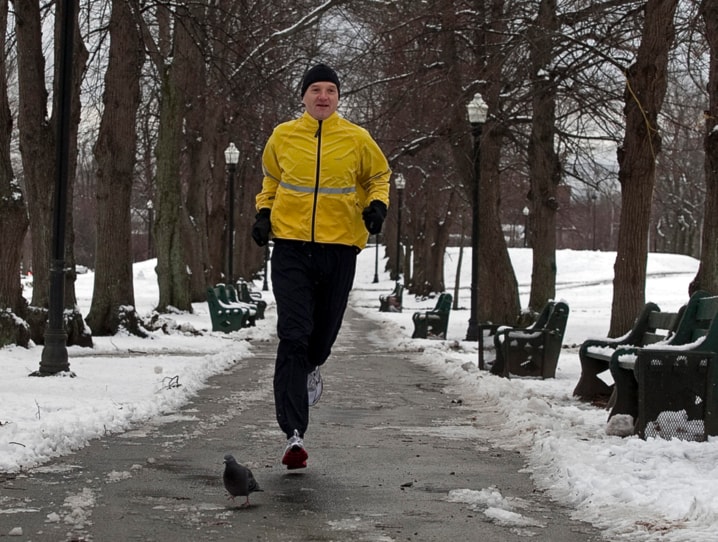Bruce Bowen doesn’t plan to abandon his workout routine and hibernate during the winter, but the longtime runner does make adjustments when lacing up in chillier weather.
A runner for more than three decades, Bowen currently heads out four times a week on runs varying between 10 to 16 kilometres. When a snowfall hits, he might reduce his distance and slow his pace, but he still heads outdoors.
“I’m not going to be trying to go for any sort of a faster pace run,” said Bowen, manager of the Running Room in Halifax.
“I’m just maintaining good footing so that I’m not going to slip, keep an eye down for where I’m going and saying, ‘Oh, that looks like ice’ and try to go around it.”
There are certain winter conditions in which Bowen might give the outdoor run a pass. For example, if the thermostat dips to minus 20 C, he will try to find somewhere indoors to take his strides.
“As far as precipitation, if it gets into like a high wind condition so it’s blowing the snow around and visibility becomes a factor then I won’t go,” he said.
“But I find sometimes going for a run at the beginning of a snowfall as the snow’s starting to come down, if the wind hasn’t picked up at all, sometimes it’s one of the most pleasant running times, because it kind of deadens all the sound.
“It makes it really quiet, and you feel like you’re the only person in the world.”
Individuals should seek out a health professional before making any significant changes in their routines — particularly with regards to exercise and the cold, said Scott Tate, director of marketing and public relations for the Ontario Kinesiology Association.
“Lack of adaptability can enhance your risk for injury or perhaps other events,” said Tate, a kinesiologist, personal trainer and continuing education coach at Body and Soul Fitness in Toronto.
“If you don’t know your fitness level well, you might not know that perhaps you’re a borderline sports asthmatic. If you have asthmatic tendencies, that cold can really enhance your potential to have an asthmatic event.”
Once individuals get the green light, they’ll need to dress in a way to ensure they stay warm and keep cool.
A wick-away fabric topped by an apparel piece that’s cotton or more absorbent, with layers of insulation and wind protection, is generally the most well-rounded approach, Tate noted.
Bowen said a shell jacket will help block the wind from getting to the insulating layer to ensure the moisture coming through doesn’t get chilled.
He recommends runners wear the same sock they use in the summer so as to not affect the fit of their shoes. But there are thicker socks designed for thermal retention to help the feet stay warmer, he noted.
Bowen said winter runners can also get shoes with a Gore-Tex lining to block the cold air from getting to their feet. Those running in a more urban environment can opt for spike-type grippers for shoes.
“Because you’re going to be hitting hard-packed snow and ice they’ll grip into that, but then on the asphalt and concrete, they’ll allow you to maintain some form of traction on there.”
When you finally do head outdoors, does a wintertime workout translate into a greater calorie burn? Not necessarily.
“Just at rest, our body has to work harder in the wintertime to keep our body at a good internal temperature, so we tend to burn more fat doing that,” said registered dietitian Tristaca Curley of the Halifax-based practice Fuelling With Food, specializing in sports nutrition. “It’s not necessarily more calories that we’re burning — we’re just burning those calories from fat as opposed to carbohydrates.”
Individuals tend to not get as thirsty in cold weather as they do working out in the same intensity in the heat, but maintaining hydration levels is crucial, said Curley, a professor in the school of nutrition and dietetics at Acadia University in Wolfville, N.S.
“We actually do still sweat a lot, but what happens is we don’t feel it because it evaporates quickly,” she said.
“There’s not a big increase in our internal temperature, so our body’s not sort of fighting to make sure we don’t overheat.”
As for food consumption, Curley said it’s important that people make a conscious effort to get their required nutrients, whether that involves using frozen fruits and vegetables or opting for root vegetables that are still available, such as squash and sweet potato.
To compensate for the lack of sun exposure, Curley said it’s also important to get an adequate amount of vitamin D. Dairy, fortified soy or fatty fishes like salmon, trout, mackerel, anchovies and sardines are foods that can help increase vitamin D levels, she said.
Online: Body and Soul Fitness: www.bodyandsoul.ca
Fuelling With Food: www.fuellingwithfood.com
Ontario Kinesiology Association: www.oka.on.ca
Running Room: www.runningroom.com
